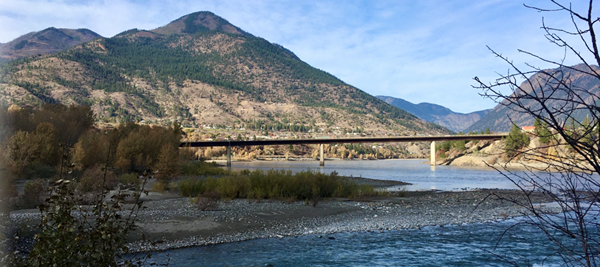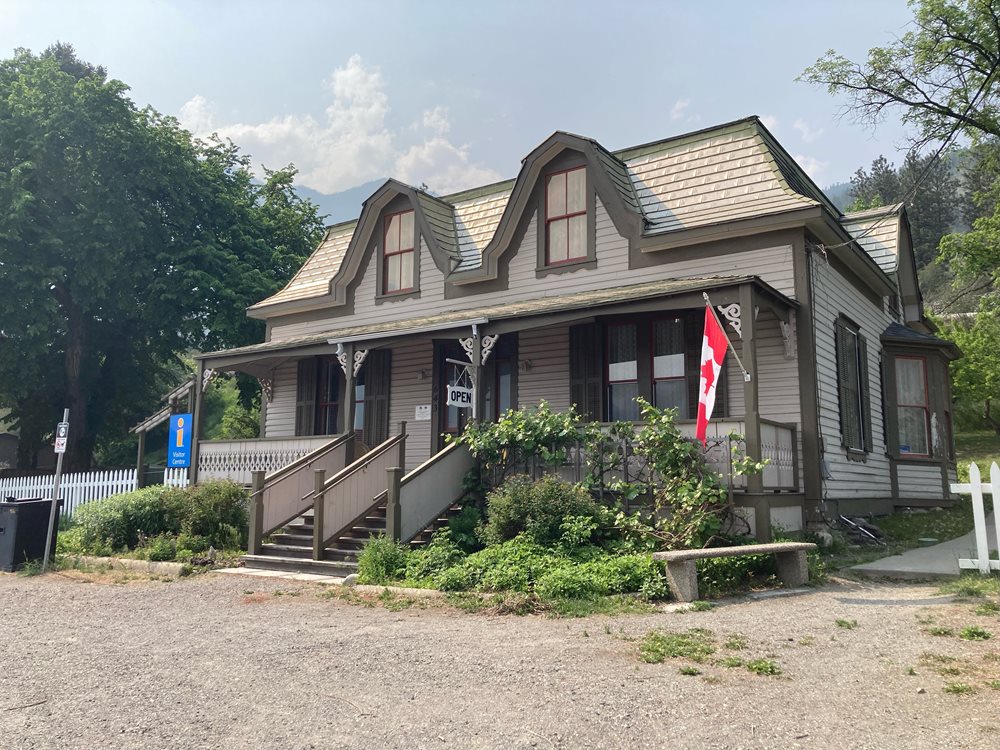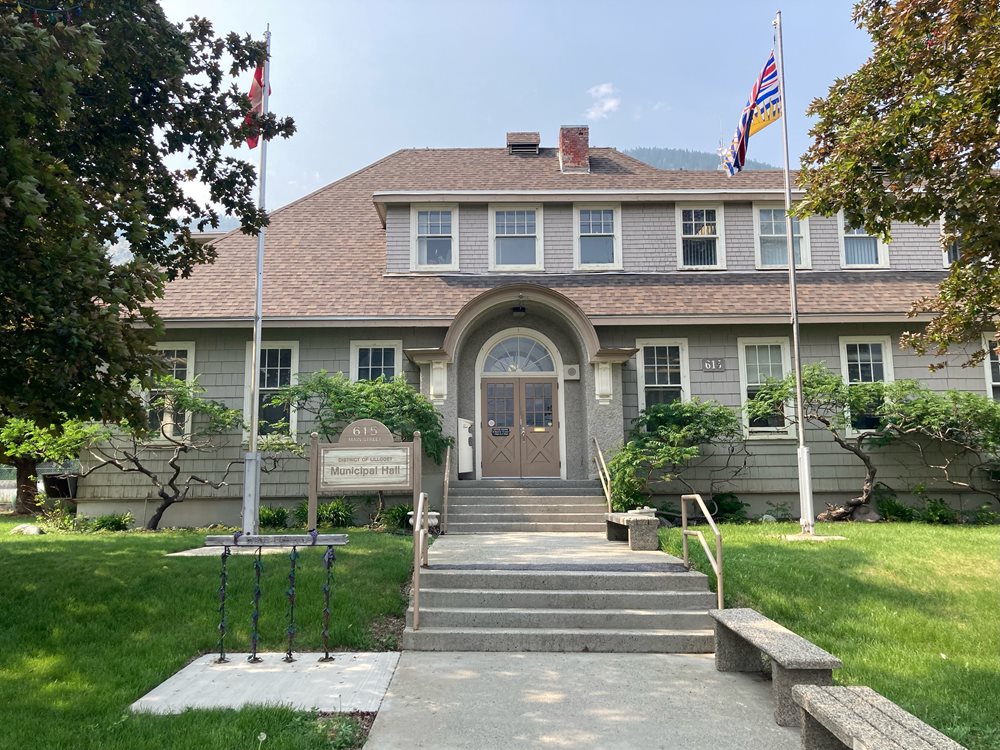Lillooet Museum
The Museum is situated in downtown Lillooet at 790 Main St, at St. Mary the Virgin, a former Anglican church, right beside Downton Park. The original chancel was incorporated in the new St. Mary's and the melodeon and bell from the old church are displayed in the museum.
The museum also features First Nations artifacts - some thousands of years old. These include Stʼatʼimc basketry, beads, and leatherwork. The museum and its board are working on introducing St’at’imc language into the display cases with the help of Elders from our shared communities.
Along side the St’at’imc history, the museum has a wide variety of settler objects from the Gold Rush and beyond including gold scales from China and Europe, Abacuses from Japan, and the finery that made up Lillooet’s population boom. Ma Murray’s famed newspapering tools are on display on the lower level and. as you enter the museum look to your left and see one of largest mounted Rocky Mountain Elk head ever registered in BC.
The Museum is situated in the former Anglican Church, St. Mary the Virgin. The original St. Mary's, which was torn down in the 1960's stood on this same spot and arrived on the backs of the miners of 1860, who carried the timber, piece by piece, over the rugged Harrison-Lillooet trail in 1860. cut and numbered for immediate assembly in Lillooet. Although it was endowed with furnishings and silver liturgical service by a wealthy English gentlewoman, the doors of the original church were never locked in 120 years. It is a matter of record that miners and other travelers slept in the church when there was no room elsewhere and cooked their food on the stove that heated the building. The original chancel was incorporated in the new St. Mary's and the melodeon and bell from the old church are displayed in the museum.
Contact:
Lillooet Museum
790 Main St
Lillooet, BC
(Find us)
Phone: 250-256-4308
Email: lillooetmuseum@gmail.com
The Museum is open May - September, daily from 10am - 4pm.
.jpg.aspx)
There are 20 interpretive panels around Lillooet. Use the map to find them all! Check out the Golden Miles of History page to read content from the signs.
B.C.'s Little Nugget: B.C.'s Best Kept Secret
In 1860 Lillooet was one of the largest cities west of Chicago, second only to San Francisco.
Lillooet's history is entrenched in the BC Gold Rush of 1860. Here, one can step back in time and see the Mile "0" Cairn and the offerings of the past as chronicled at the local museum. Lillooet was Mile "0" on the Cariboo Pavillion Road (the first wagon road to be surveyed in BC and the route to the Cariboo gold fields).
Today you can visit Lillooet's history by walking along Lillooet's Golden Mile of History.
The Old Suspension Bridge
Since the construction of the Bridge of the 23 Camels, this old span is know as "The Old Bridge" to people who live in this community. It was built in 1913 and is a suspension bridge or steel cables and wood with 'dead men' embedded in the rock banks of the river. The middle of the bridge is held up by cables. This bridge replaced a winch ferry that was powered by the river current and had been in use since 1860. In 2003 the District of Lillooet along with the Ministry of Transportation completed a restoration of the Old Bridge. The District of Lillooet with the Lillooet Naturalist Society decided to make the old bridge "bat friendly" and Bat houses were installed as part of the restoration project.
The Bridge of the 23 Camels
Bridge of the 23 Camels Following the discovering of gold in the Cariboo in 1858 and the completion of the first wagon road to Lillooet, horses, mules and oxen were used to haul the heavy loads to the gold fields. Then one entrepreneur had the bright idea that camels would be ideal pack animals, and so 23 two humped Bactrian camels were imported from Asia to BC. But the bright idea soon turned into a nightmare as the high-strung beasts ate miners clothing, kicked at anything or anyone who came close, frightened other animals with their pungent odour, and had their soft feet cut to ribbons on the rocky mountainous roads. So they were abandoned by their owners and left to roam in the wild. Some were killed for food, some died in winter storms, while others were kept as curiosities. The lone surviving Bactrian camel, “The Lady” as she was called, died around 1896 on a farm in Grande Prairie, BC (now known as Westwold). Before the bridge officially opened in 1981, a contest was held to select a name. Local resident, Renee Chipman submitted the winning name: "Bridge of the 23 Camels" in honour of those original camels.

BC Rail Station
The old Pacific Great Eastern Railway reached Lillooet in 1914 and continued on into the Interior of BC. Its name was changed to the British Columbia Railway in 1972. The station seen today was built in 1986, replacing the old station that had been constructed in the 1920's. The original route of the railway was also changed at one point. The track originally crossed the Fraser River at Cayoosh Creek, but was eventually rerouted through Lillooet to a crossing north of town by the Old Bridge. The old railway bridge was torn down in 1932.
The Mile "0" Cairn
The Mile '0' Cairn was erected in 1939, marking Mile '0' of the old Cariboo Road. From this point in the early stage coach days, all road houses and stopping places from here to Barkerville were known by their mileage from Lillooet - 70 Mile, 100 Mile, and so on. In 1858, Governor James Douglas ordered the construction of a wagon road from Fort Douglas on Harrison Lake to Lillooet. The Royal Engineers supervised the construction while miners with picks and shovels contracted to build the road for the sum of five English pounds each, which they received upon arrival, by land and portage, at Lillooet. 16,000 gold seekers outfitted here in the next four years, until 1863, when the Fraser Canyon route from Yale finally reached Lytton providing an alternate route.
The Chinese Rocks
On both sides of the Fraser River at Lillooet one can find "Chinese Rocks" - a reminder of the search for gold by Chinese people before the turn of the century. Washing the sand and gravel for the elusive yellow metal, the Chinese neatly piled the washed rocks, in some places more than 12 feet high, in long rows. Close to the Hangmen's Tree one can find an example. Others are just downstream from the Old Suspension Bridge and on the east side of the Fraser.
Miyazaki House
Miyazaki House was originally called Longford House and designed in the Second Empire Mansard style characterized by a steep roof and dormer windows. It was built for prominent Lillooet citizens Caspar & Cerise Phair by master builder William Duguid in the late 1880s.
Caspar held a wide range of official positions during his career including schoolteacher and Gold Commissioner. In 1887, Cerise bought the general store on Main Street and the Phairs enjoyed a cultured and prosperous lifestyle in the heart of a wild frontier town.
The Phair’s son Artie took over the management of the family store at age eighteen but his passion was photography. While taking pictures at Bridge River (now South Shalalth) during WWII, he met Masajiro Miyazaki, a Japanese Canadian doctor interned there with his family.
Lillooet was without a doctor at the time so Artie drafted a petition that allowed the Miyazakis to move into the lower floor of the family home and set up a medical office in a front room. In 1947, Dr. Miyazaki became the legal owner.
In 1950, Dr. Miyazaki became the first Japanese Canadian to hold public office when he was elected to the Town Council. In honour of his many achievements and contributions, he was invested into the Order of Canada in 1977.
Prior to his passing in 1984, Dr. Miyazaki donated the house to the town of Lillooet and it has been known ever since as Miyazaki House. His office is as he left it.
The Miyazaki Heritage House and grounds may be rented for private functions and is open to the public during July and August.
The Miyazaki Heritage House and grounds may be rented for private functions. For Fee Schedules, contact the Miyazaki House Society: Ph. 250-256-6808.

Municipal Hall
The now Municipal Hall was originally the Provincial Government building that was built in 1926. Later additions and renovations have altered the original French provincial design of the structure. Today the Provincial building is owned and occupied by the District of Lillooet. Provincial Court is held monthly and Conservation and Probation maintain office space in the building.

Hangman's Tree
Hangman's Tree This old Ponderosa Pine tree is located on the bench above Main Street. Turn left at the United Church and head up the hill. "Hang" a right at the first road you come to, and there, on your left in the park above the road, is the tree. It was used as a gallows for the administration of justice more than 100 years ago, when the law in these parts was Sir Matthew Baillie Begbie. The bough which actually accommodated the noose has since rotted off and the gnarled old pine has been cut down but remains on site. There is a record that two thieves were hanged there and buried underneath, but legend has it that in all, eight lawbreakers swung from it. If you don't think the walk is worthy of the story, it is certainly worthy of the view - beautiful!
The Camel Barn
This was the original News office's horse barn. But before the turn of the century, Lillooet's famous camels were kept in it from time to time until it was converted into a livery barn. George Murray made it into a theatre during World War II and reinforced the hand-hewn logs with bridge timers from the old Nine Mile railroad bridge. The building was later stuccoed and dubbed the Log Cabin Theatre. It was written up in the New York Times and the show business trade journal, Variety, as the smallest theatre on the continent.
The Old Newspaper Office
The old 'salt box' frame house, once ringed with porches, is the former home of the Bridge River - Lillooet News. The paper was established in 1934 by MLA George Murray, who founded the paper as a campaign promise to the Lillooet residents of the day. It was made famous by his wife, Margaret, who gained fame as the inimitable "Ma" Murray. The masthead of her paper proclaimed: "Printed in the sagebrush country of Lillooet every Thursday, God Willing. Guarantees a chuckle every week and a belly laugh once a month or your money back. Subscriptions in Canada. Furriners . Circulation 1573 this week and every bloody one paid for." The house is now a private residence.
Jade Trail
British Columbia is the number one source of jade in the world today. The history of jade in Lillooet is from time immemorial.
Jade is part of the geographical history of the region and can still be found on the shores of the local rivers and in the surrounding mountains. Jade is found only in certain unique areas where two rock formations shift, thereby allowing jade to surface
from its source fifteen miles deep under the earths crust. Lillooet is lucky to be one such rare place. The local First Nation community used jade as a trade staple - trading north, south and west within other indigenous communities. First Nation peoples made axes, deer scrapers and other tools for daily use from jade. Ceremonial figures were also carved from this gemstone and are documented in historical records.
The Chinese gold miners were amazed to find jade here when they came to construct the railways and to search for gold. Gold was their cash source, but jade held a special honour in their hearts, where it was thought to bring health, wealth and happiness into their lives. British Columbia's rich jade heritage served much of 19th century Chinese nephrite jade carving.
Jade is still being found along the rivers and local rock-hounders, including First Nations people, have collected and worked with jade over the years. Their commitment and donations have led to the Jade Monuments Project.
Gold Panning: Gold Country
Gold in Gold Country! Feel the surge of excitement course through your veins as you see the glint of the shiny mineral sparkle in the sunshine! The swirling waters of the mighty river flow past you as you stare at amazement into the bottom of your pan.
GOLD! Come and try your hand at this exciting activity.